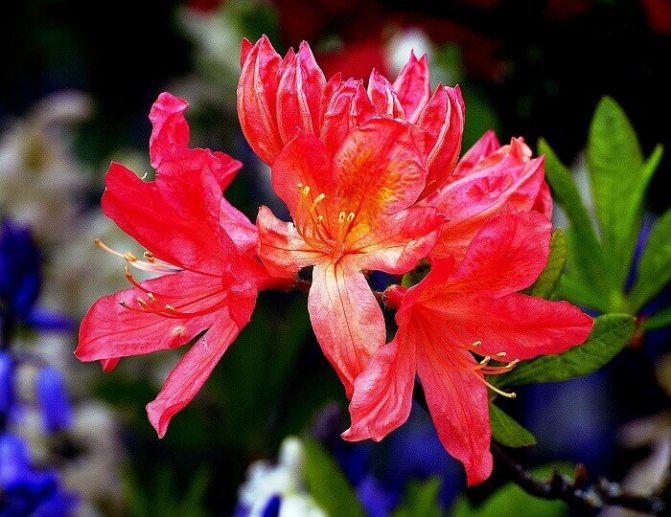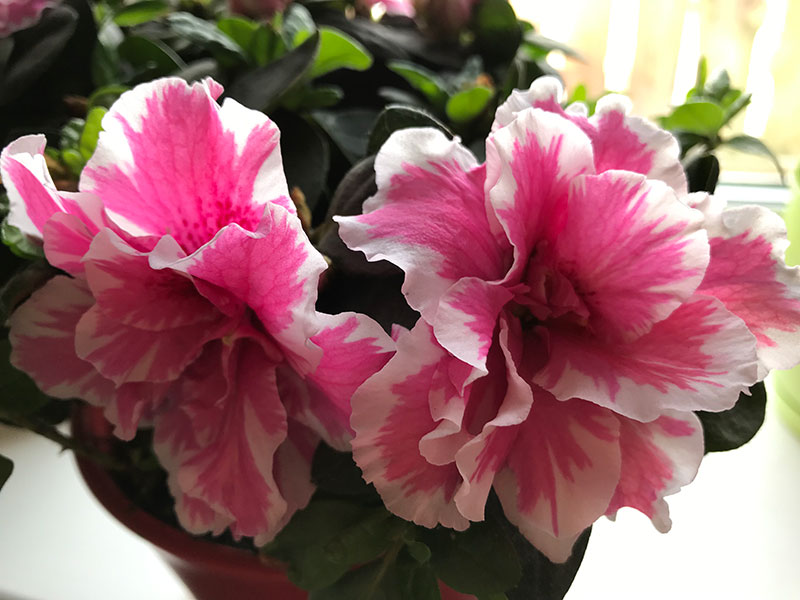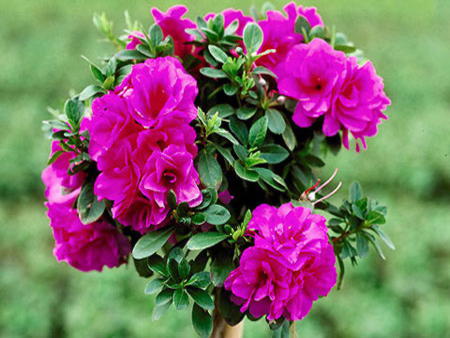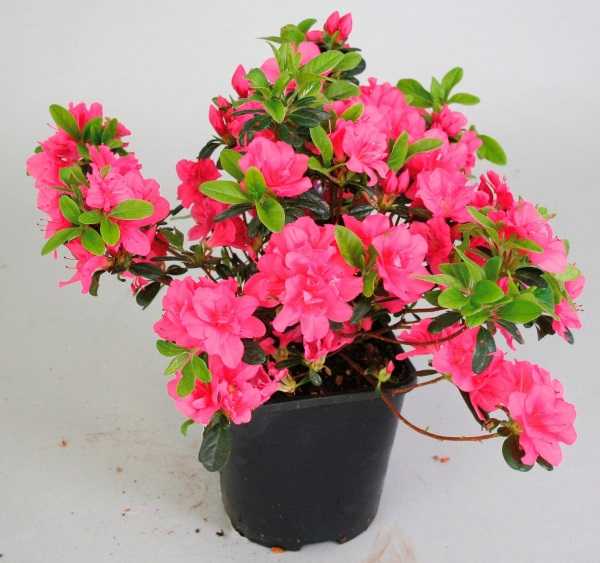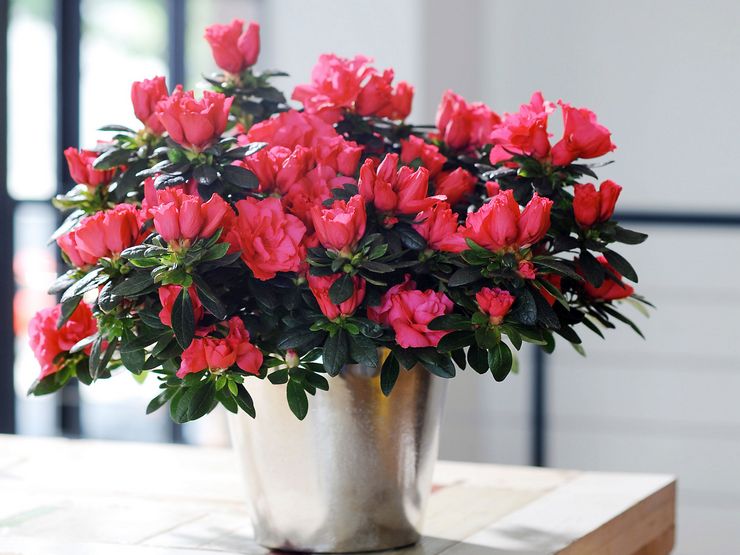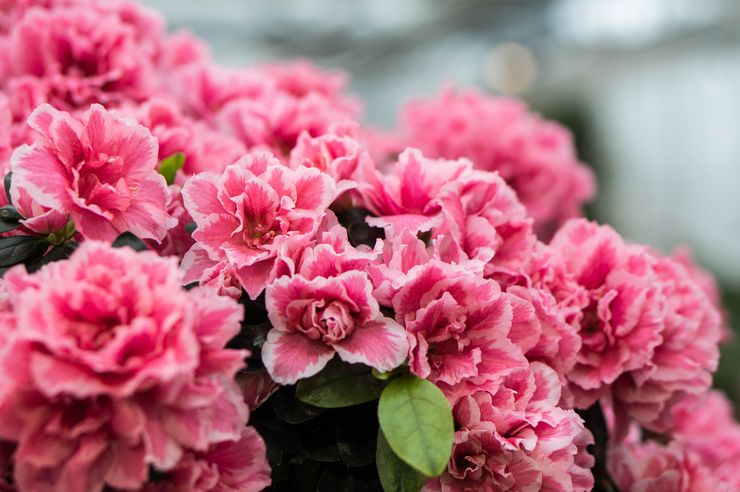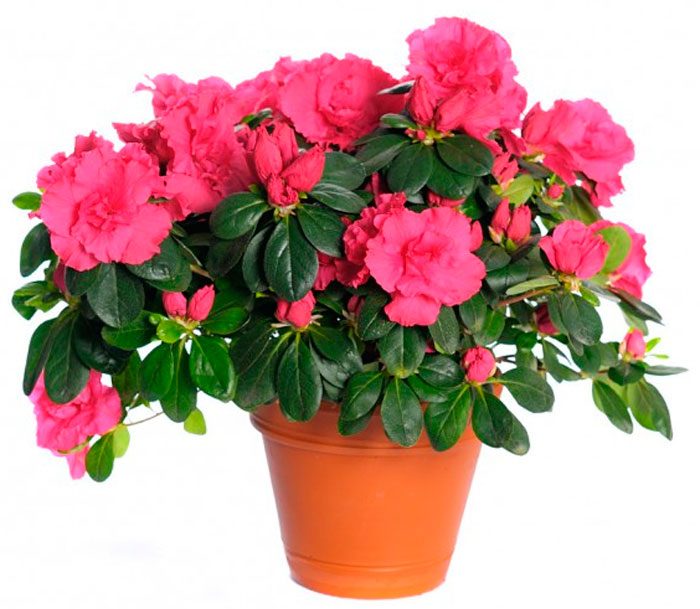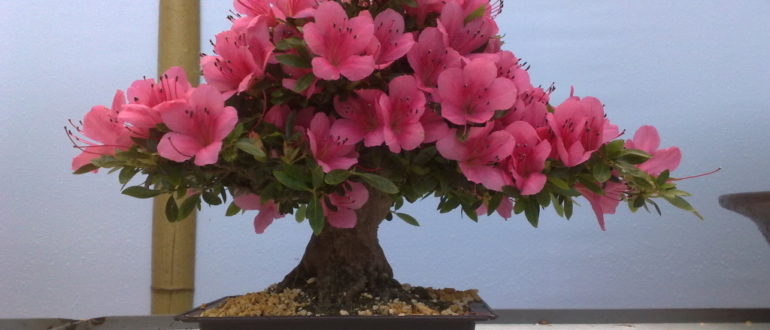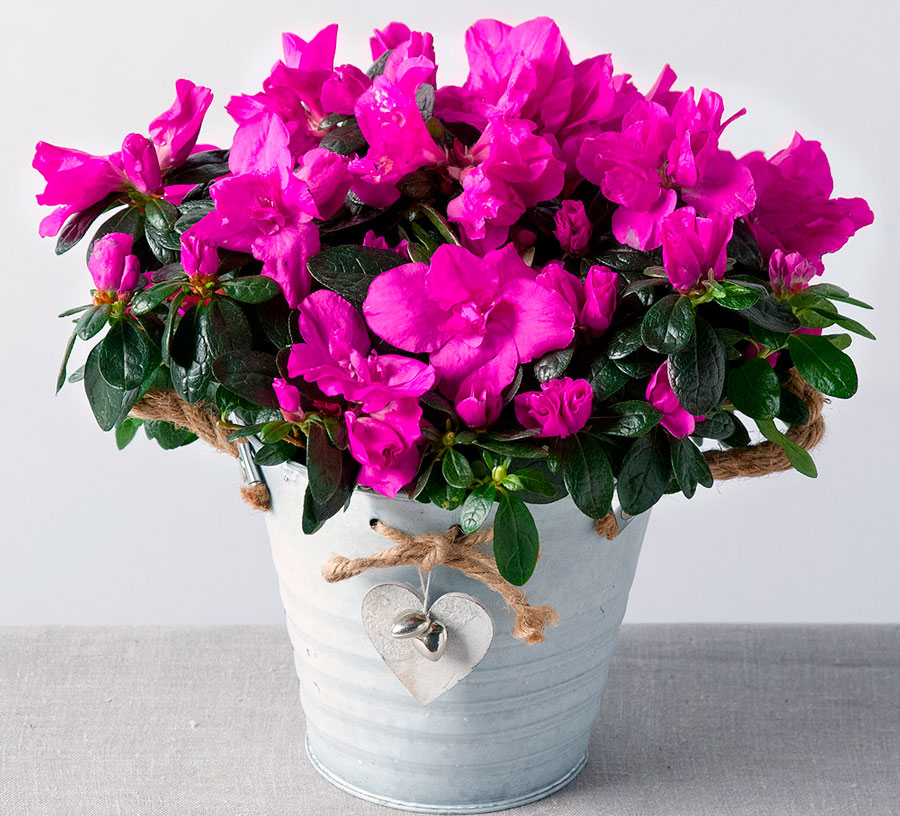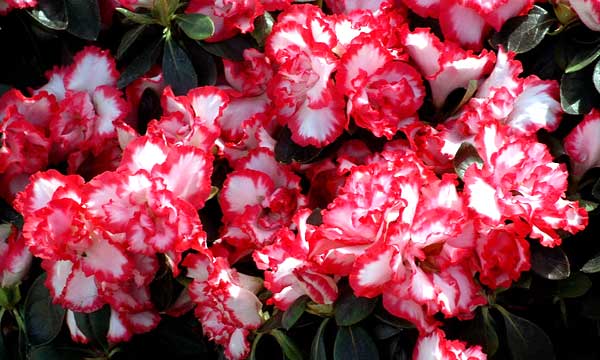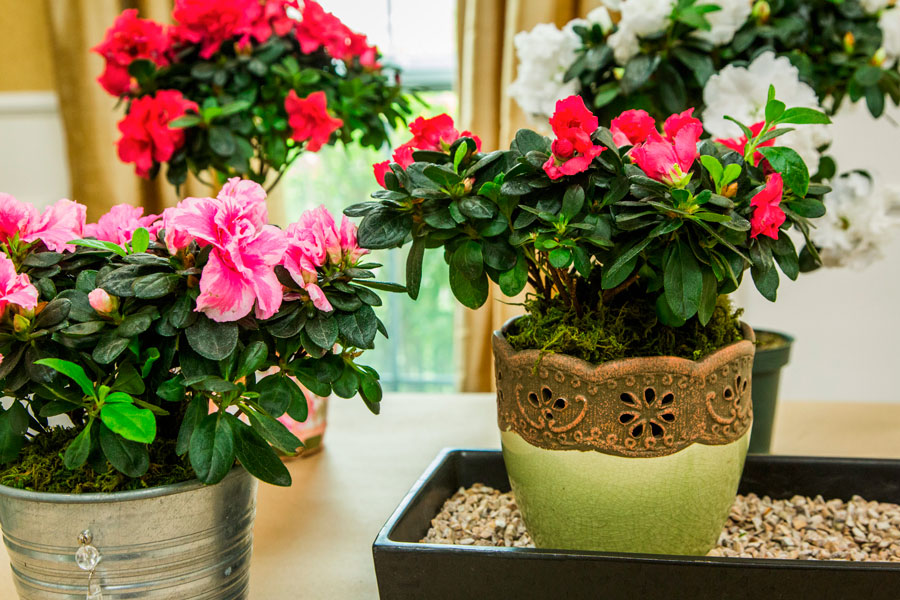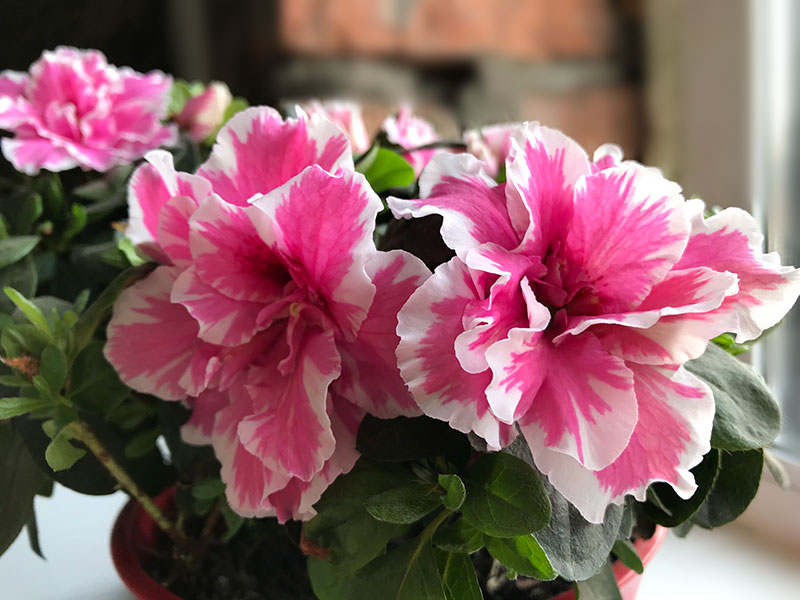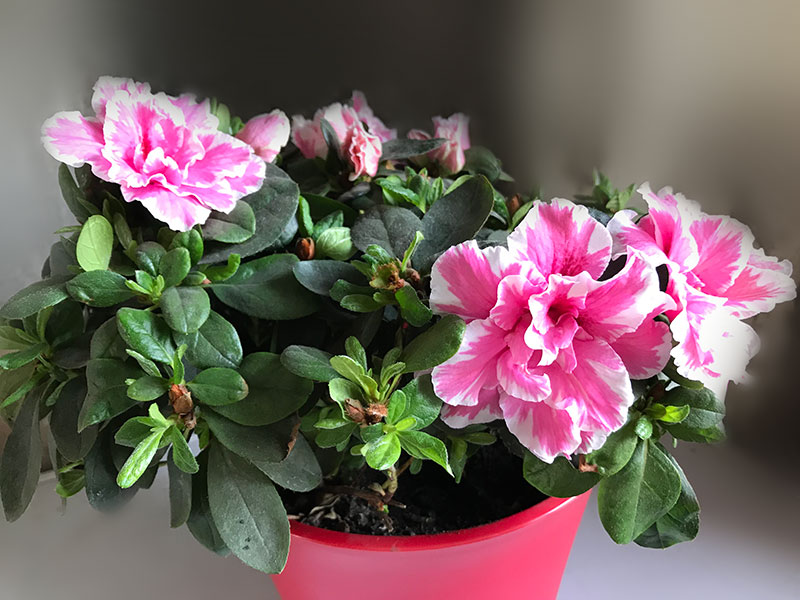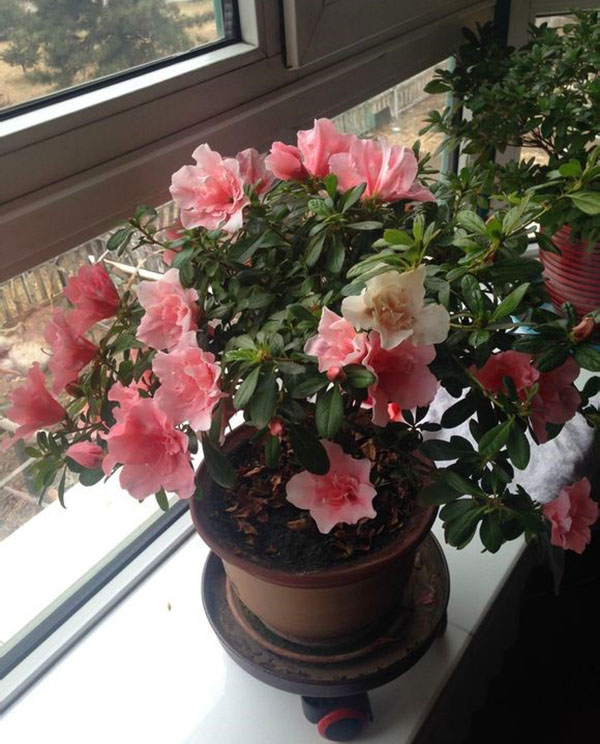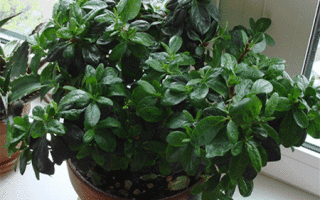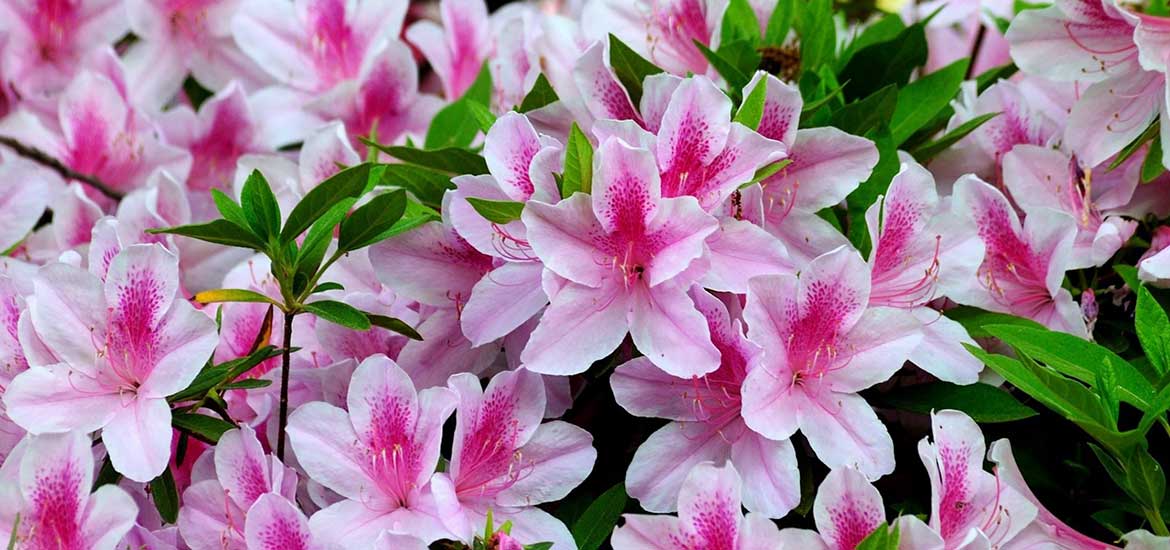How to take care at home?
When buying, you need to choose only a flowering plant. After flowering, it is kept in a warm room for about 7-14 days.
Not worth buying azalea with falling leaves or flowers, with overdried soil.
Do not remove from the package immediately, let it stand for half an hour in it.
Carefully remove the flower from the package and locate it. First, put it on a saucer, then on a pallet with wet expanded clay - if it was overdried in the store
If, on the contrary, it was flooded, cover the plant with absorbent material and leave it on for a while. Repeat until the ground is dry enough.
On the second day, the flower should be watered with a zircon solution and sprayed with it. After two days, carry out the procedure with a solution of phytosporin (10 drops per glass of water). Alternate them for 3 weeks.
It is very important to remember all the rules for caring for azalea at home after purchase, because if you follow them, the plant will not be afraid of any diseases and pests.
Transfer
It is not worth replanting an azalea without urgent need. This should be done no more than once a year, until she is 3 years old, and twice if older. Read about the optimal timing for transplanting an azalea here.
Overgrown roots or soil decay can be grounds for transplanting. Azalea soil is suitable for sour, light, with a high permeability of water and air. When preparing the mixture into a special soil from high moor peat, add 1-2 shares of coniferous land, 1 share of peat composition.
When transplanting, the amount of soil is slightly increased, as is the capacity for it.
Watering
The soil is always required wet. Avoid excessive moisture or stagnant water. For irrigation, rain, snow or spring water is most suitable, slightly worse - settled tap water. It shouldn't be cold. Watering from a pallet can also be used - for this, the pot should be placed in a container of water for 3 - 4 hours. Better if you alternate top watering and from the pallet.
It is advisable to add several grains of citric acid per 1 liter to the water. On the hottest days, water several times a day. In the fall, watering should be reduced. In the autumn-winter period, it is carried out from a pallet. In greenhouses in winter, snow or ice is spread around the plant for watering. In a warm room, a significant difference in temperature between the roots and the crown of the plant can adversely affect it.
Air humidity
Azaleas need sufficient moisture, so they need to be regularly sprayed with a spray bottle. In dry and hot weather, it is recommended to increase the number of sprays to 2-3 per day.
During flowering the plant should not be sprayed.
Do not place it next to heating or other appliances that dry the air.
Light and temperature conditions
Bright sunlight is suitable for the flower, but diffused, and not direct rays. The best option for her would be placement from the southwest and southeast sides.
The most suitable temperature for a plant is 15-18 degrees, but not more than 20-22x. It is impossible to keep an azalea in a hot and stuffy room. During the period of budding, the plant requires a lower temperature (7-9 degrees). Airing is necessary, but drafts should be avoided.
Top dressing
For this, the most suitable special fertilizer "Azalea". In the spring-summer months, fertilization is required weekly, in the autumn-winter months - monthly.
Fertilizers, which contain a lot of phosphorus and potassium, are suitable to activate flowering. At the end of flowering and during the growing season, fertilizers with a high nitrogen content are suitable.
To prevent yellowing of the leaves, use iron-ammonia alum (0.5% solution). From time to time it is useful to treat it with phytosporin at the rate of 10 drops per glass of water.
Another feeding option is ferovit. It is used for chlorosis, improves the appearance.
To adapt the plant and stimulate flowering, zircon is suitable - 2-3 drops each. It can be used both for watering and spraying, but not more often than after 3 days.
Under what conditions is azalea kept in the store?
The conditions in the flower shops are adapted to the entire range of ornamental plants for sale. Each of them should receive individual care at home.

Indoor azalea does not require specific conditions of detention
When purchasing an azalea, they check the conditions of detention. Step-by-step instructions for choosing an azalea in a store:
- Choose a medium-sized plant. Such an instance is easier to transfer and transport.
- The soil in the plant pot is moderately moist.
- You need to make sure that the leaves are firmly attached to the branches of the shrub, otherwise it will die.
- It is better to opt for a bush that has recently faded or is just picking up buds. Such an instance is easier to adapt at home.
It's important to know! When viewed externally, the leaves of a healthy plant should be free of pests and traces of their presence (cobweb). Azalea leaves must be clean and free of stains
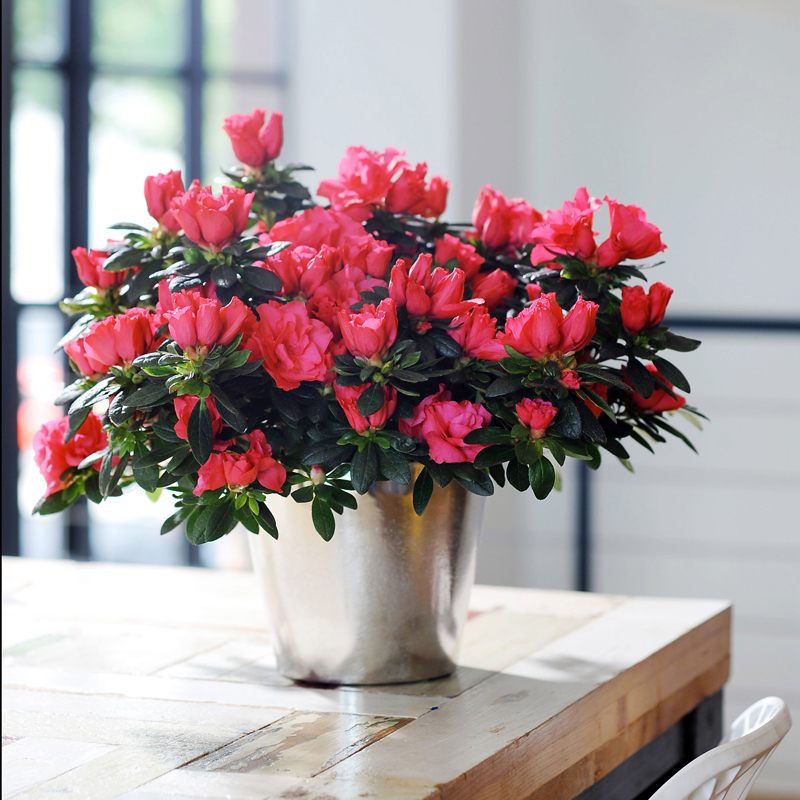
The appearance of a healthy flower
Difficulties of cutting room azalea
Azalea is able to reproduce by cuttings. Shoots taken from the bush during pruning are usually taken as material. But if they are too short and have not had time to woody, the cuttings will not take root.
The problem with cutting azaleas is that rooting takes a long time - from 3 months to six months. If the cutting is not ripe, it strongly evaporates moisture through the green skin and does not have a sufficient supply of nutrients, all efforts will go to waste. Therefore, it is better to take material for cuttings from old parts of the bush.
The process of propagation of azaleas by cuttings is as follows:
- a strong ripe shoot is selected and cut so that its length is about 20 cm;
- the lower leaves break off, only the apical leaves are left;
- in the lower part of the cutting, 2 incisions are made in the bark, about 2 cm long, a thin strip of bark is removed and part of the bast is exposed;
- the cut is processed with a weak solution of "Heteroauxin" for 12 hours;
- the glass is filled with sour wet peat;
- the stalk is buried in peat;
- the glass is placed in a warm and bright place and covered with a glass jar.
It is desirable that the greenhouse be provided with bottom heating. Rooting is better at a temperature in the lower zone of about + 25-27C. The greenhouse is ventilated daily.
The percentage of successful rooting when cutting azaleas is low - from 5 to 50%. The bark incision, the acidic environment of the substrate and the bottom heating increase it by an average of 70%.
Step-by-step instructions: what and how to feed rhododendron?
There are popular drugs that do their best.
Pocon
Pokon is a universal fertilizer that is well absorbed in the soil and helps the plant to be healthy and maintain all its external and internal parameters.
The composition is very rich in nutrients such as:
- nitrogen;
- phosphoric acid;
- potassium;
- iron;
- copper;
- molybdenum;
- boron;
- manganese.
Application: dilute 10 ml of fertilizer in 1 liter of water. In the cold season, reduce the dose by 2 times. Can be used at any time.
Bona forte
It is a growth stimulant for rhododendron, consisting of a complex of nutrients. Includes:
- phosphorus;
- nitrogen;
- magnesium;
- potassium;
- boron;
- iron;
- vitamins (B1, PP, C);
- cobalt;
- manganese;
- succinic acid.
Instructions for the use of Bona forte: for root feeding - 10 ml per 1.5 l of water; for spraying: 5 ml per 1.5 l of water.
Mineral dressings should be used under general instructions:
- Dilute in the desired ratio (indicated above).
- Pour at the root.
Manure
For those who are interested in whether it is possible to fertilize rhododendrons with manure, we will tell you that this dressing is usually used 2-3 weeks after flowering. For efficiency, you should take into account some features and follow the recommendations.
Organic fertilizer should be:
- old;
- semi-rotten;
- to maintain acidity - only cow (not recommended bird, horse and others).
Application:
- We dilute the fertilizer in warm water (ratio 1:10).
- We leave to ferment for 5 days.
- Dilute with water until light brown.
- Water (always at the root).
We recommend adding potassium sulfate (about 20-25 g) to 10 liters of water.
succinic acid
It is a growth stimulant, an auxiliary substance in the development of azaleas. It is used as an additive to the main fertilizer.
Application: if this substance is in tablets, then it should be crushed to powder:
- Put the powder (in the amount of 1 g) in a convenient container and fill it with a small amount of water (preferably warm for better dissolution).
- Stir and top up to 1 liter.
- Water the plant at the root.
You can store the prepared drug for no more than 3 days. You can apply it pointwise on the leaves if necessary. The procedure can be repeated every 2-3 weeks.
When buying for the amount of the active substance itself, since in many cases the powder contains more additional substances.
Azalea indoor - home care
caring for this indoor flower is quite difficult
But if all the conditions for normal life and growth of a flowering tree are met, it will always delight you with its delicate beauty.
How to care for Azalea after purchase
When buying a plant, pay attention to medium-sized bushes, as it will be difficult for a large one to get used to the new conditions of detention, and a small one may turn out to be weak and get sick. When you bring the flower home, do not immediately take it out of the packaging material, it is advisable to let it stand in it for a while - about 40 minutes
After removing the packaging, the bush must be given several hours to adapt, and then you can transplant it. Before planting, it is recommended to thoroughly rinse the roots of the plant with running water, and then place it in pre-prepared soil. Once you plant the Azalea, you can start grooming and growing at home.
It is better to place pots with indoor plants near windows located on the east side, taking into account that they do not get direct rays of the sun, but there was enough light. Water a recently transplanted flower with settled water at room temperature. In the first few days, it is advisable to feed Azalea with special fertilizers, for example, zircon.
Lighting conditions and temperatures
Azaleas need good lighting, but for this you do not need to put the plant on the sunny side, since this indoor flower loves diffused light. In the summer, you can take the bush out into the fresh air, for example, on the balcony, since oxygen is very useful for growth. It is very good if rain gets on the plant, this will positively affect its well-being and development.
When caring for an indoor flower, it is very important to observe the correct temperature regime. Under natural conditions, Azalea grows in a rather cool environment and this is very suitable for her.
When keeping at home, you should try to maintain a suitable temperature, since if the plant is too hot, it will begin to shed its leaves, after which it may die.
- In the autumn-winter period, the room where the flower is located should be about 12-16 degrees.
- In spring and summer, the plant should not be allowed to be hot; during this period, a moderate temperature of about 20-25 degrees is suitable for it.
- When the buds are forming, it should be pretty cool, from 10 to 13 degrees.
To comply with all temperature conditions, on hot days, you can use an air conditioner, cover the pots with dry ice, or spray the houseplant with cold water. In winter, it is better to take the flower out to a cold and glazed balcony.
For the comfortable existence of Azalea, a room with high humidity is more suitable, which can be provided in several ways:
- Spray the bush with cool water two or three times a day. One condition must be observed here - not to do this during flowering, because the flower petals can darken from moisture.
- You can place an aquarium near a houseplant, or put buckets of water, it will evaporate and humidify the air.
- You can buy a special air humidifier in the store, which is very effective.
Watering and feeding
Watering a home flower should be regular, it is necessary to ensure that the soil does not dry out and there is no stagnation of water. The soil where Azalea grows should always be slightly moist. It will be very good if the water for irrigation is always slightly acidic, which is very beneficial for the plant and can provoke abundant flowering. To do this, you can add a little citric acid to the water. It should not be forgotten that after the onset of autumn, watering should be reduced.
High-quality care for Azalea includes the use of settled water at room temperature for irrigation. The flower will really like it if you water it with rain, river or melt water, just make sure that it is not cold, this can negatively affect its root system.
With good home care, the plant needs regular feeding. After the onset of spring, you can begin to feed the earth with useful substances. This should be done periodically, before the onset of cold weather. Usually, feeding is done once every 10 days and for this it is necessary to use mixtures enriched with useful substances, suitable for room Azalea, which are served in special stores.
Plant soil is best fed with the following microelements:
- Once a week - ammonium nitrate and superphosphate.
- Potassium sulfate.
- During the flowering period - a solution of superphosphate, 15 g per 10 liters of water (for irrigation).
Reproduction
Carried out by cuttings. Basically, cuttings are prepared in the warm season. The preparation of the cuttings is carried out as follows: the semi-lignified shoot should be about 10 cm in length.
An undercut is made under the lower rudiment. The lower leaves should be completely cut off. And the rest are cut in half. Then the cuttings must be placed in the place of the cut in Kornevin's solution.
After 7 hours, the petioles should be planted with a small vessel with nutrient soil. For quick rooting of cuttings, it is recommended to use a special heating.
Cuttings need to be given appropriate care: water them daily and arrange regular ventilation. Remember that it is necessary to water young plants with settled water. When the cuttings take root, they need to be moved to new containers filled with coniferous soil. After 8 weeks after transplanting, it is recommended to pinch the cuttings, thanks to this, a magnificent bush can be formed.

Home care instructions
How to make the desired shape from a regular plant?
Many growers are wondering where to start forming bonsai with their own hands. First of all, you need to get ready, since the process will be long and painstaking. This is due to the fact that such a form does not exist in nature and it is unnatural for a shrub.
To form a bonsai, a young plant is chosen that lives no more than a year. During the first pruning, the largest and widest shoot is selected - it is on this that the bonsai will form. The rest of the branches are deleted.
At first, you do not need to cut the length of the shoot. The main task of the grower is to grow a strong trunk of the desired height. In order for the shoot to grow evenly, it is recommended to tie it to a support, and also periodically turn it to the light in different directions. In this case, growth will be faster and more even.
Once the center trunk has grown to the height you want, you need to pinch the top of it. All further actions will be aimed at forming the crown. To maintain a beautiful shape after flowering, the shoots are cut off, leaving only 4-5 leaves on each
Choosing a landing site
The plant should be protected from drafts and direct sunlight. It is best to choose a sunny location with diffused light.
The soil
Dense and clayey soil is not suitable for Azalea bonsai. The best option is a substrate with moderate acidity and a lot of nutrients. It is best to purchase a ready-made soil mixture called "Azalea".
How to grow from seeds?
Sowing azalea bonsai seeds is a laborious process. Seeds are sown in January-February. It is recommended to pierce the soil for planting in the oven, and then cool it - this will protect the plant from many diseases. Seeds are placed in the finished soil at a distance of 15-20 mm from each other, they are slightly pressed down. The seed is gently sprayed with water and covered with a transparent lid or oilcloth.
The suitable temperature for growing seeds is 19-23 degrees.
In the first 2-3 weeks, it is recommended to cover the seeds with a matte film.
After the first shoots appear, the container is placed in a well-lit place, but the oilcloth is not removed. As soon as the shoots have reached 2-3 cm in height, peat is sprinkled between the shoots. It promotes the growth of new roots, which prevents the seedlings from falling.
As soon as 3-4 leaves appear on the sprouts, it is dived in separate containers, but the shelter is not removed at the same time. When the dived seedlings adapt, the oilcloth is removed for a while - they start from 15-20 minutes. After 7-10 days, the cover can be removed completely.
Temperature
Azalea bonsai prefers moderate temperatures:
- In the summer, the most optimal indicators are 18-21 degrees above zero.
- And in winter, it is recommended to withstand 15-17 degrees above zero.
Azalea is an unpretentious plant, therefore it will withstand temperature surges up to +25 and up to - 30 degrees.
Watering
One of the main conditions for growing Azalea bonsai is constantly moist soil and high air humidity. It is recommended to take settled water or rainwater to moisten the soil.
Watering is carried out as soon as the upper 2-3 cm of the substrate is dry. Food acid can be added to the water - 1 g per liter. At least once a week, the plant is sprayed with a spray bottle.
Top dressing
The plant especially needs feeding when new growth appears on the branches. It can be distinguished by its light green color. Fertilizers are also applied during the formation of buds. Complex fertilizer in liquid form is best suited.
As soon as the leaves begin to crumble, the amount of nitrogen in the fertilizer should be reduced.
Pruning
The most important thing is to remove withered flowers and dried leaves. Every 3-4 years, a radical pruning is necessary when the minimum length of the branches is left.
Pinching of the shoots is carried out regularly so as not to spoil the shape of the bonsai.
The lower branches grow much faster than the upper ones. Therefore, to maintain the shape of the bonsai, the lower part is cut more.
Transfer
To make the root system feel spacious, the young plant is transplanted every year. After 3-4 years, the frequency of transplants is reduced to once every two years.
It is recommended to transplant in early spring, when new leaves are just appearing on the plant. During transplantation, examine the root system and remove dead roots.
Outdoor irrigation
Regarding how much lilies love watering, one can say one thing - for them underfilling is better than overflowing, that is, the need for irrigation always depends on the state of the soil, therefore, regularity in their case is a relative concept. The composition of the soil also affects the frequency of irrigation - soil with a predominance of clay and peat is dense in itself, and water leaves it slowly, so the number of irrigations can be reduced, in contrast to looser types of soil, in which the sand in the composition is superior to other elements.
Abundant moisture can be detrimental to the plant, since excess water displaces oxygen from the soil, leads to decay of the root system and the development of fungal diseases.

Watering in the summer has its own subtleties.
- On clear sunny days, evening irrigation is more preferable, since in the morning with the rise of the sun, moisture quickly evaporates, which does not even have time to nourish the roots. If it is not possible to water the flowers in the evening, the soil under the lily bushes should be mulched with fresh cut grass - this will protect the soil from drying out.
- It is important to water the plants shortly before the setting of the daylight, so that before that moment the water has time to be absorbed, since constant watering at dusk over time leads to the growth of pathogenic bacteria.
- When caring for garden plants, one should not forget about regular loosening and weeding, which prevents stagnation of water.

On your site for lilies, you can create an automatic irrigation system, taking into account some points.
- The surface and rain method for this crop is only suitable in warm weather, at night and in the evening. As with most other garden flowers, splashes on flowers and leaves cause sunburn.
- Due to the fact that the level of moisture in the soil is difficult to control, for such a bulbous plant as a lily, intra-soil watering is not suitable either.
- It remains to use the drip irrigation complex, which is a system with the inclusion of an intake and filtration unit, as well as distributing drip lines, which will also be useful for applying liquid fertilizers.
- You can water the flower beds from a regular watering can with a nozzle that helps diffuse water. At the same time, there is no strong pressure, and the soil under the lilies is not washed out.


For the winter, the bulbs left in the ground are protected with shelters of coniferous spruce branches and are not watered until the snow melts. Only when the soil warms up slightly is it allowed to gradually and in small quantities begin to water the plant.

With your own hands
For outdoor species of azalea, organic feeding is effective. Horse manure, pig manure, cow manure and chicken manure can help improve soil nutrients. Horny waste is also popular. These include shavings, flour. This fertilizer can also be used for indoor azaleas.
Important! Natural fertilizers should only be applied in liquid form.
The main types of preparation of organic preparations for azaleas in the open field:
- Manure. To prepare a mixture, you need to combine one part of water and 15 parts of manure. The liquid must be mixed well and left for several days. You can apply the product after bubbles begin to appear on the surface.
- Slurry. There are no specific proportions. During the preparation process, you must focus on the color of the mixture. It should have a light brown tint.
- Superphosphate and slurry. Such a mixture will allow the soil to be saturated with the required amount of phosphorus. You need to combine 100 liters of manure and 4 kilograms of superphosphate.
- Rotted manure. This product does not need to be diluted in water. The composition must be evenly placed under the bushes. This should be done in spring or autumn. The thickness of the humus should be within 5 cm.
Any kind of organic fertilizer should be used very carefully. Frequent application of manure can change the acidity level of the soil.If the leaves begin to change their shade, you should immediately add drugs that increase the pH.
How to moisten the soil after purchase: step by step instructions
Consider the detailed instructions for watering.
Read how to provide the necessary home care for your azalea after purchase.
What should be the temperature of the water?
As a rule, it is preferable to water azaleas with water at room temperature, two to three degrees higher than the temperature of the soil. Then the plant will not experience stress or damage. Watering with ice water is categorically contraindicated: because of it, development slows down, the flower gets sick, and the delicate roots irreversibly deteriorate. On hot days, it is better to cover the pot with ice or snow, then the irrigation will be softer and more accurate.
How often to moisturize rhododendron?
Watering frequency may vary depending on the season and the condition of the flower.
Constant moderate watering - 1-2 times a week. In hot dry weather, it can increase up to 3-5 times, and in winter, on the contrary, not more often than once.
During the period of bud formation, it is correct to water the plant once every couple of days, after the beginning of flowering, the frequency increases - but the volumes decrease
It is important to monitor the condition of the soil and track the need for irrigation after the fact.
It can even be said that the frequency of watering an azalea is determined solely by the characteristics of the land. The question of whether it is time to water the rhododendron can be easily resolved: dip your finger into the soil to a depth of 3-5 cm. If the ground is already dry, then irrigation is necessary, otherwise you can refrain.
We suggest watching a video on how often you should water the azalea:
Dosage
There are no definite specified and calculated volumes for irrigating azaleas, it all depends on the condition of the soil and microclimatic conditions. Make sure that there is enough water to fully moisturize the soil.
After watering, wait until excess moisture drains into the pan: it must be eliminated, protecting the roots from possible decay. Rhododendron loves moisture, but is by no means a marsh plant. Therefore, the soil in which it grows must be sufficiently permeable.
Top or bottom, into the pallet?
There are several ways in which you can water the azalea, both indoor and garden (it is recommended to alternate them for more successful plant development):
- Pouring into the pallet. For this method, a pot with a flower is placed in a special tray filled with water at room temperature to a level of about 1 cm. The soil itself draws in the amount of liquid it needs, but this method is associated with several nuances.
Firstly, with such irrigation, the upper layers of the earth may not be sufficiently saturated with moisture, and secondly, if the soil is particularly loose and sandy, then there will be nothing to absorb the liquid, and the azalea simply will not receive water. This type of watering should not be applied more often than 1 time in 3 days.
- Top irrigation. The traditional and simplest method is to pour water from the top into a pot using a watering can or other similar device. Here it should be borne in mind that it is not recommended for water to fall on the leaves and the jet should be directed as close as possible to the root of the main stem. This type of watering can be carried out with the frequency of drying of the top layer (2 cm) of the earth.
- Full immersion. This cardinal method is used in exceptional cases: when the soil, the plant itself is strongly drying out, or during the transplantation process. The process is the extraction of a flower from the soil and its immersion in a container of water corresponding to its dimensions. For better further growth, it is recommended to add zircon preparation (again, read the instructions carefully).
Sprinkle the azalea with cool water once a week (under normal ambient conditions). It is customary to introduce fertilizers during irrigation during the budding and flowering period, about once every 15 days.
Common mistakes
To avoid the death of the azalea, the following guidelines must be followed, which indicate what not to do:
- Overfeed the plant with fertilizer (if it is inorganic), as this will damage the roots of the plant. If transplanted into a new soil treated with zircon, it does not always help and saves.
- The composition of the wrong acidity in which the azalea lives can also destroy the plant. Therefore, read the labels carefully or consult a specialist.
- Spray during flowering.
- Avoid granular fertilizers.
- Do not feed in hot weather to avoid root death.
For prevention, we recommend: timely add acidifying trace elements, add nutrients in liquid form, do not buy preparations containing chlorine, and moisten the soil.
Thus, if you follow all the basic recommendations for caring for a beautiful azalea plant, you can easily grow it at home and admire it even in winter. But before that, it is worth taking the time to thoroughly prepare before the cold. The correct selection of fertilizer and its precise application will enrich the plant and provide it with all the necessary nutrients for a long life.
How to fertilize at home?
For splendor and bright inflorescences, each grower should know the nuances of introducing nutrients into the azalea soil.
During budding
In the period June and mid-July, to prepare the plant for flowering, it is necessary to apply fertilizers containing nitrogen to the soil. Further, budding occurs: during this period, the plant is in great need of superphosphate components. They are introduced with the calculation of 15 g per 10 liters of water, do not exceed a concentration of 0.15%.
You can use the universal "Uniflor-Bud", the complex components are directed specifically for this period.
During flowering
Only fertilizers, which include phosphorus and potassium, can accelerate the flowering process. Spraying of plants is prohibited during this period.
For the plant to bloom
Stimulation of active flowering is necessary not only for beauty, but also for the proper development of the plant, active root formation. Means suitable for this period:
- Zircon - very adaptable to azalea and promotes root growth. Application: before use, the ampoule must be held in the hands or warmed up in the sun (since all components are activated only after the supply of heat); for convenience and accurate application, fertilizer can be applied through a syringe (2-3 drops are enough).
We use this drug without overdose. For efficiency, you can use a spray bottle.
- Epin is an anti-stress for azaleas. Spraying is carried out no more than once every 14 days. But its effectiveness is much less than the first drug. Restriction: cannot be used during the flowering period and is destroyed in the light.
- To accelerate the growth of azalea and remove it from stress, you can use HB-101. It only takes 1-2 drops for watering or spraying.
- You can also use "Eco-gel-antistress" or iron chelate.
Top dressing is one of the important stages of azalea care, but not the only one. On our website you can read about pruning, post-purchase care, watering, and optimal keeping conditions.
Watering differences
Before and during flowering
- Before the azalea becomes blooming (March-October), watering should be reduced. The exception is July-August, when you need to water the flower in the morning and in the evening.
- From autumn to winter, when buds and buds are laid, watering is also reduced to increase them.
- After the appearance of buds and buds, it is necessary to water the plant regularly, do not overfill it, but also prevent dryness.
At different times of the year
Learn how to properly water at home and how often your plant needs water in summer, winter, fall and spring.
The season also affects the watering of rhododendron:
- from March to September it is carried out every other day, in the summer months - every day;
- from October to November (inclusive) watering is reduced;
- in winter, the plant needs watering 1-2 times a week (if the room is hot and there is increased dry air, it is necessary to spray the leaves in the morning).
Indoor and outdoor flower
Indoor and outdoor types of azaleas require different care:
- In the case of room azalea, watering must be reduced when the air temperature drops and increased when the air temperature rises.
- The frequency and intensity of watering a flower planted in a garden or on an area depends on the weather and the place of planting.
Therefore, if the plant is planted in an area with a high level of underwater water, it should not be watered too often. A plant planted in high, sandy areas requires frequent and abundant moisture. In this case, the norm for watering is one or two buckets every other day.
In the case of young, only planted seedlings, half a bucket 2-3 times a week will be enough for watering.
Before and after rhododendron transplant
The transplant is carried out during the emergence of new shoots. Young shoots are transplanted annually, adult shrubs once every three years.
If the plant is not transplanted, then the roots can form stagnant moisture, which leads to rotting of the soil. In addition, various diseases and parasites can occur.
Transplanting and watering azaleas is carried out in several steps:
- The plants, pulled out of the pot, are placed in a container with boiled water.
- In the same water, it is necessary to dissolve zircon, which promotes better root formation, and phytosporin-m, which protects against fungus.
- In the resulting liquid, the plant should stand for 50-60 minutes.
- After the specified time, the rhododendron is transplanted into the soil and watered with the same solution in which it stood.
After transplanting, it is necessary to water every two to three days, while growth stimulants are added to the water.


